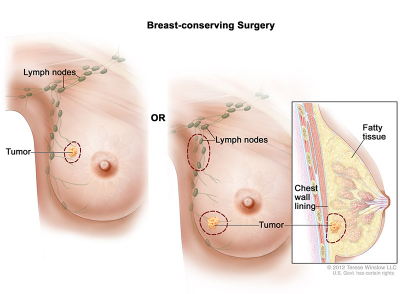Breast Conserving Surgeries
Breast-conserving surgery, a common surgical option for women with early-stage cancer, preserves most of the patient’s breast. The cancerous tumor cells are removed while leaving as much of the normal breast tissue as possible. In most cases, a certain amount of surrounding healthy tissue and lymph nodes are also removed. Tumor size, location and other factors determine how much of the breast may need to be excised. Most women who have breast-conserving surgery will also need radiation.
Lumpectomy is the removal of the breast cancer (the "lump") and some of the normal tissue that surrounds it (a margin). Lumpectomy is a form of breast conserving surgery.
There are several names used for breast-conserving surgery:
- Excision
- Lumpectomy
- Partial Mastectomy
- Re-excision
- Quadrantectomy
- Wedge Resection
Technically, a lumpectomy is a partial mastectomy because part of the breast tissue is removed. The amount of tissue removed can vary greatly.
- For breast cancers that are palpable (cancers we can feel), surgery removes the palpable area and a rim of normal tissue (the margin).
- For breast cancers we cannot feel (non-palpable), a localization procedure is done to help identify the abnormality prior to surgery so the surgeon knows what area and margin to remove. This can be done with a mammogram localization or an ultrasound localization.
Some women who are lumpectomy candidates may be interested in oncoplastic techniques.

Reference: https://www.breastcancer.org/treatment/surgery/lumpectomy
Oncoplastic lumpectomy combines plastic surgery techniques with lumpectomy surgery to give you a better cosmetic outcome after the cancer is removed.
You can think of oncoplastic lumpectomy — also called oncoplastic surgery or oncoplasty — as a reconstructive surgery aimed at preventing problems with the breast’s appearance that can be caused by the lumpectomy. It is usually done at the same time as lumpectomy.
There are many different oncoplastic approaches that surgeons can use to reshape the breast after removing the cancer. These choices are tailored to the cancer’s location and size, as well as an individual woman’s breasts, body, and preferences.
Oncoplastic surgery techniques are generally used to either:
- Rearrange nearby breast tissue to fill in the space left behind after the cancer is removed to prevent “dents” and place the scar where it is less visible
- Remove the breast tissue containing the cancer and combine this procedure with a breast reduction, a breast lift, or both (this is the most common)
If necessary, the surgeon can alter the other breast to create a symmetric appearance.
If you’re eligible for lumpectomy, you may want to ask your surgeon if an oncoplastic approach makes sense for you.
Traditional lumpectomy vs. oncoplastic surgery: What’s the difference?
Lumpectomy — also called partial mastectomy or breast-conserving surgery — removes the breast cancer and a rim of healthy tissue called a margin, preserving most of the breast. In some cases, a divot or dent forms and causes a visible indentation of the breast or can distort the appearance of the nipple. Radiation therapy can also change the appearance and shape of the breast and scar.
Oncoplastic lumpectomy combines plastic surgery techniques with lumpectomy to both remove the cancer and reconstruct and reshape the breast. It can be useful for achieving a good cosmetic outcome in many women who choose lumpectomy, such as those who have:
- Mid- to large-sized breasts and the need to have a large amount of tissue (20% to 50%) removed from the affected breast
- Existing issues with their breasts, such as excessive sagging (ptosis), very large size (macromastia), or obvious lack of symmetry (balance), which could be addressed at the same time the cancer is removed
Oncoplastic lumpectomy is not an option for inflammatory breast cancers. The procedure also may not be possible if there are multiple tumors throughout the breast, unless the breast is quite large.
Reference: https://www.breastcancer.org/treatment/surgery/reconstruction/types/oncoplastic-lumpectomy
![]()
